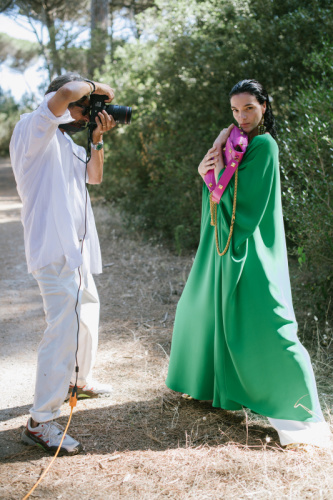
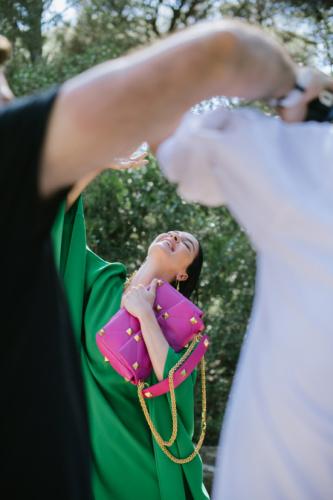
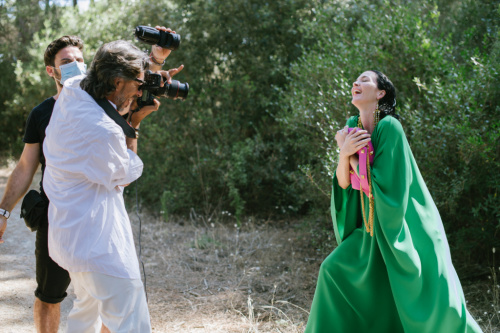
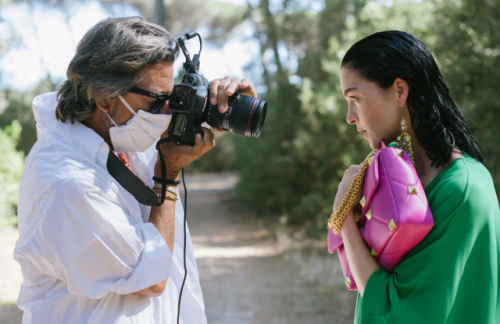
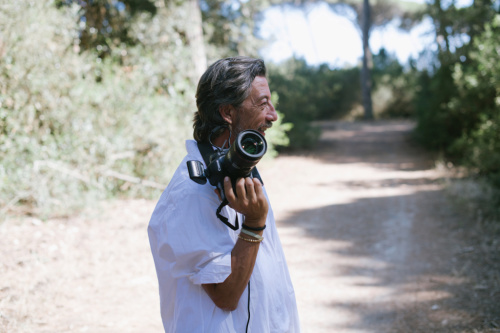 Bridget Foley’s Diary: Pierpaolo Piccioli Gets It Done
Valentino’s creative director talks about making fashion work — big-picture and, for resort — in these most fraught of times.
Bridget Foley’s Diary: Pierpaolo Piccioli Gets It Done
Valentino’s creative director talks about making fashion work — big-picture and, for resort — in these most fraught of times.
By
Bridget Foley on July 2, 2020
In ordinary times,
Pierpaolo Piccioli would almost certainly have made a brief sojourn to New York in June. He would have presented his resort collection for
Valentino before rushing back home — to Rome and the idyllic-sounding, commuting-distance town of Nettuno, where he lives with his family — to ready his couture and men’s collections.
These times are anything but ordinary. Like so many others, Piccioli has spent the spring and early summer sequestered, reinventing work processes in the era of work-from-home. Early on, it was about figuring it all out. Then, it was about getting it done. Piccioli seems to have fared just fine because this week he’s “presenting” two collections, resort first and then couture. Resort will break when
Valentino posts the collection’s campaign pictures to social media on Monday. Not just any campaign shoot, mind you, but one he shot, in his hometown, of a dear friend, the glorious Mariacarla Boscono. They’ve known each other for years, since she showed up for a fitting at Fendi when she was a kid. Mariacarla’s not a kid anymore. In a Zoom chat, Piccioli offered that she’s the perfect person for what he wants to express with this collection. “She’s a woman, she’s very aware, she knows fashion…” he said. “I think that she’s the right one to interpret this kind of mood — intimate but very aware.”
We’re intrigued, and asked photographer Vanni Bassetti to stop by the shoot — safely.
Here, Piccioli talks about the collection, photography — and more.
WWD: You’re obviously proceeding with collections. How goes the Zoom working life for you?
PierpaoIo Piccioli: At the very beginning it was different, but even interesting to be alone and to be able to think a lot, to reflect about what I was doing, what it could mean.
WWD: Reflection time.
P.P.: To be able to stop everything, to be alone and thinking and drawing and sketching and painting, doing research. It was a different way of working and actually, I kind of like it. Maybe it was also a need for me to be alone and to think. Of course, I’m linked with my team by Zoom.
But I alone, I was not in the rush of everyday routine. Now I’m sure it impacted a lot. It has a big impact on the collection because I have been thinking of the collection in a different way, thinking of the needs of the collection.
WWD: The needs of the collection?
P.P.: Yes. The needs of the people that for sure have changed. I think that now people are kind of different. And maybe I am different. I wanted to do a collection that was less, with fewer pieces. Designed but simple in a way. I did exactly what I had in my mind; I have it in my mind every collection. I want to solve the complexity around simplicity.
So the collection is planned as very simple, but it’s simple because all the complexities are solved. I have been drawing the pieces. This is a collection made with paper and pencil. No styling. Just paper, pencil and drawing, and thinking of the construction.
The difference is that it is really simple but has something in terms of construction. The silhouettes are great when they are sketched and they become alive on a woman because they’re very fluid, super fluid and free. Probably I was feeling the idea of freedom, of less constriction, more of a sense of escapism.
WWD: Escapism. We can all use some of that.
P.P.: I was not thinking of a holiday collection. For me it’s very urban and essential, but designed and not basic.
WWD: On the mood boards Blair [Trader, Valentino p.r.] sent, you have architecture pictures, party pictures from the Seventies, and later, Mark Rothko art. How does it all come together? I assume that the color is key.
P.P.: I wanted these volumes to be defined by the colors. The colors are definitely part of the creation of the pieces. It’s like when Rothko defines volumes with colors. I wanted to handle it in the same way, not to use the color as decoration but as the essence of the pieces. I used many different shades of red, pink, green, blue, but for these pieces to be worn in a free way. So you can put together a top, bottom, trousers, skirts, shirts, in a way that creates different families of colors.
WWD: There are several pictures of Mr. Valentino’s work, by Peter Lindbergh, Walter Chin and others. The clothes are all red. Are you paying particular attention to “Valentino red?”
P.P.: Not really. Just strong colors generally.
WWD: Accessories?
P.P.: I worked a lot on accessories with the atelier. Remember in the March show, I presented the rose bag, the bows, the ruffles, and I was going to continue in this direction, working on the red, rose reds. I wanted the accessories to be very iconic. I wanted the iconic signs of the house [bows, ruffles, etc.] to be the logos of these bags because they don’t have [actual] logos. The logos are the identity of the house, which is something different for accessories.
The bags are made with straw and different materials, with the bows and ruffles in toile. I love the idea of a red-carpet dress, very Valentino, translated into something very contemporary. So let’s say that red dress [in a photograph] from 1959. It’s now a tote bag in clear, and I made it in a clear [material], so very organic, very. It has a different attitude, much more daywear, more contemporary, more facing the moment.
WWD: And you have some very comfortable-looking shoes on those mood boards. Birkenstocks and sneakers.
P.P.: I am going to shoot next week and I want to do a collection without filters, like a diary between Mariacarla and me. It’s going to be a moment between the two of us because we are friends. I want to shoot the collection because I want to deliver the feeling I had when I was drawing it — no filters, so no stylists, no hair, no makeup. No photographer, of course because I am shooting.
I want something more personal, more intimate, very couture because the collection is very close to the kind of daywear pieces of couture. Couture because of the cut and not because of the volume.
WWD: Have you ever done your own photography at this level, for this level of exposure?
P.P.: I just did an editorial for a magazine. I did a series of portraits of people I like. So my wife, my daughters. I like shooting people I have a relationship with. When you shoot someone you have a relationship with, it’s a different kind of picture. It’s more intimate, you feel something more human. It’s not about the glamour of the picture. It’s more about the people who are involved, and probably giving something more personal and more emotional.
WWD: How long have you known Mariacarla?
P.P.: Twenty-five years, something like that. Probably 30 years. She was a kid when I met her for the first time, probably like 14, at the very first casting she did at the time. At Fendi, with Karl in Rome.
WWD: Apart from the friendship, why is Mariacarla right for this collection right now?
P.P.: She’s a woman, she’s very aware, she knows fashion. And for sure, this is a very fashion collection for me. Fashion in terms of cut, volumes, silhouette. I wanted a woman who would wear this collection, not only as a model, but also in real life. I think that she was the right one to interpret this kind of mood, intimate but very aware. Extravagant enough to be daring and not to be safe and only with good taste. I love the idea of being daring, being extravagant [and] being very personal. She does self-expression in a picture, I want her personality. I didn’t want just a face or a body, I want the personality, and she definitely is a personality.
WWD: Are you and she going to style on set or are you going to do it ahead of time?
P.P.: She will come to my home with her daughter and her dog, with my family, with some close people on the team, so very few people. I will send her the collection, she will try it on. [For the shoot], I’ll go around in my home and the places I love very close to my home [in the town of Nettuno]. I want to shoot also in nature, the woods and the sea. I think also that we’ll go out for dinner and she’ll wear something. I’m going to shoot if I like the picture.
WWD: Are you at all concerned about revealing so much of your personal life in these pictures?
P.P.: Not really, not really. I think it’s time to be unfiltered. I think that my job already says a lot of my personality. It will be a diary between the two of us. I mean, I’m really excited to do this.
WWD: You always talk about emotion, the emotion of the clothes, the work, the process and about your atelier “family.” How important have those relationships been in working remotely?
P.P.: I missed it a lot, the physical relationship I have with everyone. But you learn to create that same kind of relationship, even not hugging people. You can hug also by saying words, talking about your life, not just talking about the job, for example. Sometimes during this period I have been talking with everyone in my company, with my seamstresses, with my team, with all of them. And you understand that it’s about human relationships. We are the company. It’s not the company itself, the name. It’s the people who are in the company, at the heart of the company. So that is probably the most important thing to evaluate, the human relationships. So I am not concerned to reveal about the house, the relationships, because it’s really authentic.
WWD: This is a unique time, maybe the most bizarre time most of us will ever live through. First, the coronavirus, and now the global social justice demands following the death of George Floyd and other police killings in the U.S. Do you stop to think, why does fashion even matter in this moment, and has it been hard for you to concentrate on your work?
P.P.: Of course I think that this moment is a very important one. Equality is the most important thing, but real equality and not just words. You definitely want to be more radical, more extreme, more — I want to be more radical in my fashion and in everything I am doing.…The idea of the Black Lives Matter movement — for me, that’s the most important thing that’s happening in the world at the moment.…So, of course, we all have to fight together in order to stop this. This is the moment that we can’t say maybe or maybe later; we have to do it now. All together.
I think that all of us are involved in the fight of Black Lives Matter. But as you know, I’ve always thought the same for every kind of community. I don’t believe that you have to be a woman to fight for [women’s] rights; I don’t think you need to be gay to fight for gay rights. And I don’t think you need to be Black to understand that this is the moment, for sure, for equality in the world. We all together have to fight for the human rights, all human rights, for equality
.
WWD: Between this and the virus, have you had trouble focusing on work?
P.P.: I like to face reality and then deliver an idea of a reaction to a reality I don’t like. I am not a mirror of reality. I want to react to reality. I want something more dreamy, more emotional, more hopeful than what reality is. So it’s about watching reality and reacting to reality with something more positive and more hopeful, for sure. But I don’t want to be the designer alone in this room with flowers and candles and not face a reality. Because I hate that idea. I think that we have to meet the world.
WWD: Do you still believe in live shows after you see that there are other ways of doing things?
P.P.: I feel, yes, that the live show is important and it’s going to be something where people are linked together in one project. But I don’t know if it has to be a [traditional] show, a performance or something different. We are preparing something for couture which is not going to be a show but it’s going to be a live event. This is off the record, I believe. [What came next was.]…
I feel that you need the emotion of the moment, to share the emotion of the moment. Even if it’s not live in that moment, even if you’re not there, I think that you have to feel that intensity of the moment.
That’s why I’m shooting with Mariacarla in a very…almost voyeuristic way, so not a lot of structure but very personal. I have [worked with photographers], with my heroes of my childhood. And I felt that they were looking for the truth of the moment. Yes, there was a moment but you have to catch the moment, you have to feel in the moment. So probably also about a performance, a live show…there’s something about the moment, and you have to share with other people.
WWD: This will run shortly before couture. Can you tell me anything on the record about what you’re doing?
P.P.: While thinking of the couture, I have been thinking that it was impossible for sure to do the classic runway show. I felt that I didn’t want to do any compromise with a show. I didn’t like the idea of a show with closed doors, with the girls alone in a room and something like that. So I thought that it could be interesting to do something different, completely different. [An interjection from a p.r. took Piccioli back off the record.]
WWD: Sounds amazing.
P.P.: For me couture has to deliver positivity and emotion. So how could we deliver the same emotion of a show, but differently? So I wanted to create another moment, another thing, another story to deliver the dream of couture and the magic of couture.
WWD: Again, sounds amazing.
P.P.: Hopefully. It’s kind of hard.
WWD: It doesn’t sound easy.
P.P.: Not easy but fantastic. And when you see the dresses themselves there’s an emotional impact. I wanted that also in the pre-collection. That’s why I’m saying I want to be even more radical. If I have an intuition or something, I want to go deeper in that direction without any kind of — going very deep in that — the idea of intuition.
WWD: Without hesitation?
P.P.: Yes. The same for pre-collection. I decided to do that kind of work on simplifying, reducing shape to this elementary outline, using color as the definition of the shapes, and I went very direct, daring, simple.
WWD: What are you doing for men’s?
P.P.: The same. I’m thinking of shape. Because the shapes are elementary, and the [ideas] are good both for men and for women. Even if the shapes for men are different, it’s the same idea of freedom, the same idea of simplicity.
WWD: Simplicity, and…?
P.P.: There are tapestry motifs from the 16th and 18th centuries that we reworked in digital, reducing all the lines and recoloring in a different way. And then, something probably more closer to Valentino in the Sixties. I always loved Valentino when he was more daring, more provocative. At the beginning of his career, when he was more unpredictable for the clients.…But when you see [the clothes], you don’t define the era.
WWD: Back to fashion shows, some houses are saying that they’re committed to the traditional show schedule; some say they’ll do their own thing. Are you committed to the traditional fashion schedule for spring and fall?
P.P.: We are thinking to do the coed show, men and women, for September. That’s what we’re committed to. But I think we have to [look at] how we proceed.
WWD: Right now, are you more inclined to stick with the traditional schedule rather than show at a different time?
P.P.: I think it’s important to create a system. For September I am going to present a show that is men and women. We are not presenting during the Paris Men’s Fashion Week, nor digitally [then].
WWD: It’s still early to call for September but do you think you might have a limited audience at the show ?
P.P.: I think so, I think so. I don’t think that it’s going to be possible to have something like March or last October. We have to be very careful. And yes, I like also the intimacy of a show. I am thinking to do a different kind of show, completely different. In a way, this moment gave us the opportunity to rethink things and the system and collections and in a different way. I decided to be more radical and more extreme, for sure. So I’m thinking of a different kind of show and I will go in that direction.
WWD: And you expect that show will include some kind of an audience?
P.P.: Some kind of audience, yes. But with a different formula of show, not 1,000 people in one tent.
WWD: Until then, your personal diary with Mariacarla.
P.P.: I’d like to share with you the pictures when I have them, so we can talk more about the clothes. I’m interested to see what will happen [with the shoot].…Because now it’s an idea. Let’s see what happens.
WWD








 . For a second I thought it couldn't be possible that both her and Virginie left their respective current positions in the same week and needless to say it was indeed too good to be true. Thanks for making me laugh after a crappy week!
. For a second I thought it couldn't be possible that both her and Virginie left their respective current positions in the same week and needless to say it was indeed too good to be true. Thanks for making me laugh after a crappy week!